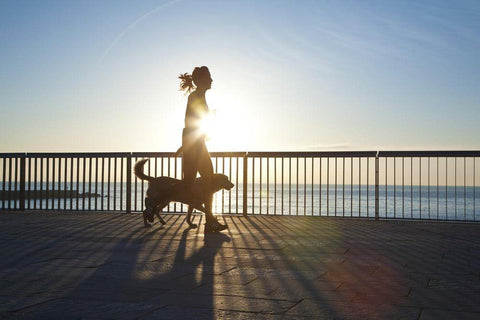There are two main components of being in shape – firstly being a normal healthy body weight and composition, and secondly being fit and capable of exercise. Luckily enough, these two components normally go together… It’s rare to see a very overweight dog who is also very fit.
The best way to tell if a dog is overweight is to feel over their ribs and spine. You should be able to feel the rib and spine bones, but when you look at the ribs and spine the bones should not be visible. Your dog is overweight if you need to push hard to feel the bones, and if you can’t feel them at all the dog is obese. On the other hand, if you can see the rib indentations the dog is underweight, and if the ribs are very visible with no significant coverage then the dog is undernourished. As far as fitness goes, a dog should be easily able to go on a thirty minute steady flat walk without being heavily out of breath or very tired.
It’s important to take breed and age into account when assessing your dog and formulating an exercise program. Some breeds such as Greyhounds and Whippets will normally have visible ribs, and others such as Bulldogs naturally have quite a solid, muscular build. Greyhounds will also naturally be fitter than Bulldogs. Also, older dogs will normally have somewhat reduced fitness and ability to exercise.

What are the top 5 ways to get your dog in shape?
Getting into shape is pretty simple. Regular, sensible exercise. When starting out an exercise program remember to begin gently and build up over a few weeks. And remember to make it appropriate for your dog’s breed and age.. Pugs can’t exercise like Terriers, and take it especially easy if your dog is very young or old. Young developing dogs, especially large breeds, also shouldn’t do very high impact exercise until at least 9 months old to allow their bones to grow and develop.
The top 5 ways to get your dog in shape are:
1. Street Walks: Sometimes the simplest answer is the best. Regular, gentle but steady walking exercise really helps build cardiovascular fitness, and is very effective at fat burning. I’d recommend two walks per day if possible, generally starting at around 15-30 minutes depending on the age and breed of your dog.
2. Trail Walks: As your dog becomes fitter, I’d recommend incorporating some more strenuous trail walks if your dog is up for the challenge. This type of exercise is excellent at building leg strength and high-end fitness.
3. Outdoor play areas and parks: Dog and owner activities such as fetch, frisbee and tug are very useful for working on fitness, and also help promote the bond between a dog and their owner.
4. Dog parks: Dog parks are great for exercise as well as dog socialisation, assuming your dog is comfortable around other pets and trained to be off-leash. Playing with other dogs is highly energetic and really helps build both muscle strength and fitness, as well as the emotional well-being from interacting with fellow canines. A handy list of the LCSD dog parks in all areas of Hong Kong can be found here.
5. Swimming: Swimming is an great, low-impact exercise that a lot of dogs love. It conditions many muscle groups and can be really useful for dogs with stiff joints. Remember that swimming is quite strenuous for dogs, and make sure they are comfortable in the water and can always get out if they want to.

How do you encourage a very lazy dog?
I think deep down all dogs love a walk and socialisation. I’d definitely say start off slow and easy – nobody like being pushed beyond their limits and coming home sore and tired. Dogs with no history of exercise may be a little unfamiliar or even nervous, especially if they don’t go outside often. In these cases I recommend people start off by just taking their dog out of the house on to the street and watch the world go by for a few minutes, and maybe give a treat or two to help build positive memories. Do this for a couple of times until the dog seems comfortable and then increase the walk to the next street corner, then around the block, and so on. If a dog starts to want to go home I wouldn’t force them to continue… better to sit for a while to build confidence then go home and start out again tomorrow.
What are the main benefits of a dog being in shape?
As with people, cardiovascular fitness and health has wide-ranging benefits. Dogs who are fit and healthy and of normal body weight statistically have better immunity, increased organ function, lower resting blood glucose levels, lower resting heart rate, are less likely to have high blood pressure, and are at greatly reduced incidence of metabolic issues such as diabetes. Add it all together and this means they will have a longer, happier, healthier life. And it’s not only about the physical benefits. Dogs who are in shape are likely to spend more time outdoors with their owners, meaning they are often more emotionally balanced, happier and enjoying all life has to offer.
Does an in-shape dog need more food?
Dogs who do a very large amount of exercise or are working dogs do need a higher calorie diet with higher levels of protein. However, most average in-shape dogs will get plenty of nutrition from regular dog food, in the normal recommended amounts. I would suggest all owners to monitor their dog’s body condition using the rib and spine checking technique described above. If the dog does seem to be getting a little thin after a new health plan I’d recommend increasing the volume of food given by around 15%, but be careful not to overfeed – you don’t want to undo all of that good work. I’d also recommend that all dogs who are doing physical exercise take a glucosamine supplement for their joints and an Omega-3 supplement for their general health (around 500mg/day of each is usually plenty for the average dog).
I believe that keeping your dog fit and healthy is an important part of pet ownership. And it pays dividends on every front – a healthier, happier, more adjusted pet, and often a happier and healthier owner too. There really are no downsides. And best of all, it’s free.























